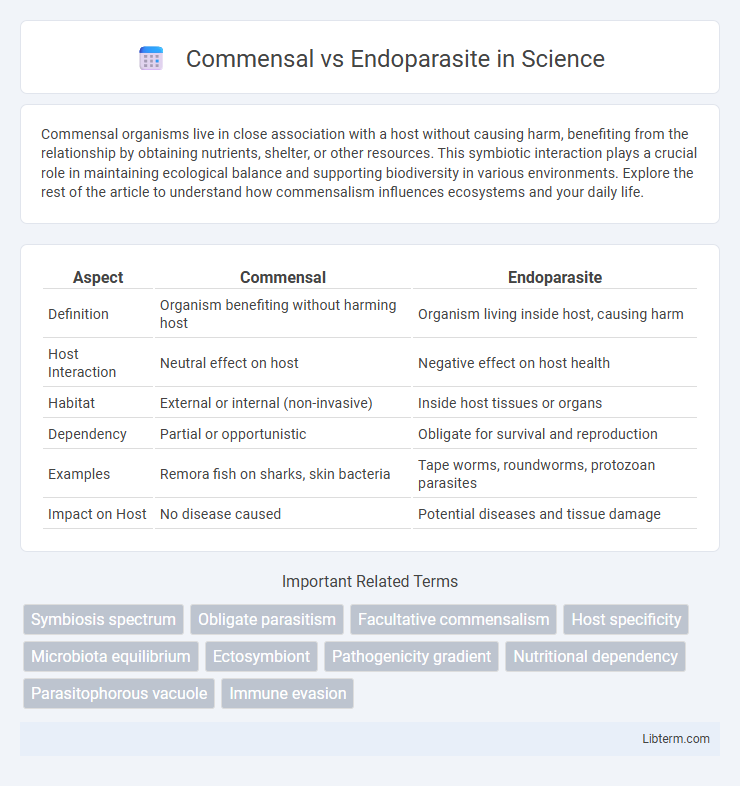Commensal organisms live in close association with a host without causing harm, benefiting from the relationship by obtaining nutrients, shelter, or other resources. This symbiotic interaction plays a crucial role in maintaining ecological balance and supporting biodiversity in various environments. Explore the rest of the article to understand how commensalism influences ecosystems and your daily life.
Table of Comparison
| Aspect | Commensal | Endoparasite |
|---|---|---|
| Definition | Organism benefiting without harming host | Organism living inside host, causing harm |
| Host Interaction | Neutral effect on host | Negative effect on host health |
| Habitat | External or internal (non-invasive) | Inside host tissues or organs |
| Dependency | Partial or opportunistic | Obligate for survival and reproduction |
| Examples | Remora fish on sharks, skin bacteria | Tape worms, roundworms, protozoan parasites |
| Impact on Host | No disease caused | Potential diseases and tissue damage |
Introduction to Symbiotic Relationships
Symbiotic relationships encompass interactions where organisms live closely together, including commensalism and endoparasitism, which differ in their impact on host organisms. Commensals benefit without harming or benefiting the host, maintaining ecological balance, while endoparasites reside within hosts causing harm to obtain nutrients. Understanding these interactions is crucial for studying ecosystem dynamics and organism evolution.
Defining Commensalism
Commensalism is a symbiotic relationship where one organism benefits while the other remains unaffected, illustrating a non-harmful interaction between species. In contrast to endoparasites, which live inside a host and often cause harm or disease, commensals coexist without exploiting or damaging their host organism. This biological interaction highlights the diversity of ecological relationships beyond parasitism and mutualism.
Understanding Endoparasitism
Endoparasitism involves parasites living inside a host organism, deriving nutrients at the host's expense without immediate death, contrasting with commensalism where one benefits without harming the other. Endoparasites such as tapeworms, roundworms, and protozoans invade internal organs or tissues, adapting to evade immune responses and sustain prolonged infection. Understanding these interactions aids in studying host-parasite coevolution, disease pathology, and strategies for parasite control in medical and ecological contexts.
Key Differences: Commensals vs Endoparasites
Commensals live in or on a host without causing harm, often benefiting from the host's resources without affecting its health, whereas endoparasites live inside the host's body and derive nutrients at the host's expense, leading to potential harm or disease. Commensal relationships are typically neutral or beneficial for the host, while endoparasitic associations result in a parasitic interaction that can impair host functions. Key differences include the impact on host health, with commensals maintaining equilibrium and endoparasites triggering immune responses and pathology.
Ecological Roles of Commensals
Commensals occupy a crucial ecological niche by benefiting from their hosts without causing harm, often aiding in nutrient cycling and maintaining ecosystem balance. Their interactions promote biodiversity and contribute to the stability of host populations by preventing overexploitation of resources. These relationships enhance habitat complexity and support various trophic levels through subtle but essential biological partnerships.
Pathogenic Impact of Endoparasites
Endoparasites cause significant pathogenic impact by invading host tissues and disrupting normal physiological functions, often leading to diseases and weakened immune responses. Unlike commensals that coexist without harming the host, endoparasites such as helminths and protozoa induce inflammation, nutrient depletion, and tissue damage. The severity of infection depends on factors like parasite load, host immunity, and environmental conditions, making endoparasites critical agents in parasitic diseases.
Host-Parasite Interaction Dynamics
Commensal relationships involve one organism benefiting without harming the host, maintaining a stable ecological balance where the host remains largely unaffected. Endoparasites penetrate and inhabit internal tissues, triggering complex immune responses and often leading to disease or reduced host fitness. The interaction dynamics differ significantly, as endoparasites manipulate host physiology for survival, while commensals coexist without disrupting host homeostasis.
Examples of Common Commensals
Common commensals include bacteria like Escherichia coli in the human gut, which benefit from the host environment without causing harm. Other examples are Staphylococcus epidermidis on the skin and various fungi such as Candida species that coexist without damaging host tissues. These organisms maintain a neutral relationship, unlike endoparasites such as tapeworms and Plasmodium species that derive nutrients at the host's expense.
Notable Endoparasites in Humans and Animals
Notable endoparasites in humans include protozoa such as Plasmodium spp., responsible for malaria, and helminths like Ascaris lumbricoides, a widespread intestinal roundworm. In animals, common endoparasites encompass species like Fasciola hepatica, a liver fluke affecting livestock, and Toxoplasma gondii, which can infect various mammals causing toxoplasmosis. These parasites live inside their hosts, deriving nutrients at the host's expense, contrasting with commensals that coexist without causing harm.
Implications for Health and Disease Management
Commensal organisms maintain a neutral or beneficial relationship with their host, often contributing to immune system development and pathogen resistance without causing harm. Endoparasites invade host tissues, leading to diseases that require targeted treatment strategies such as antiparasitic drugs and immune modulation. Understanding the balance between commensal microbiota and endoparasitic infections is crucial for developing effective health interventions and managing disease outcomes.
Commensal Infographic

 libterm.com
libterm.com